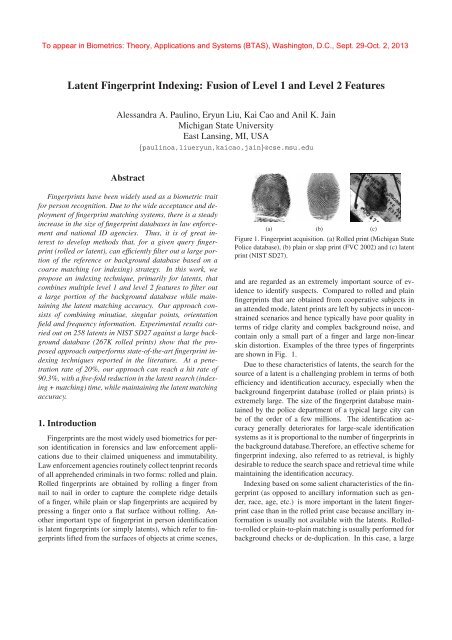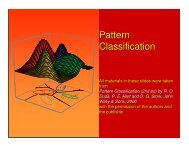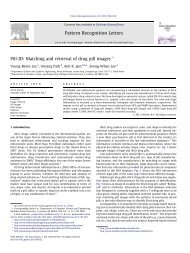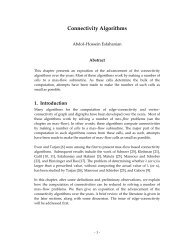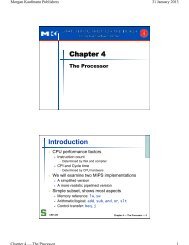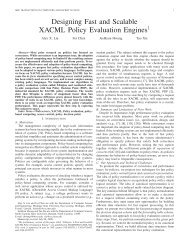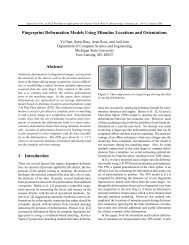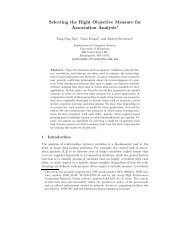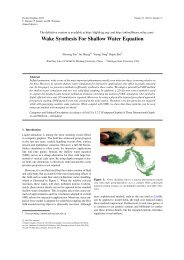Latent Fingerprint Indexing - Computer Science and Engineering
Latent Fingerprint Indexing - Computer Science and Engineering
Latent Fingerprint Indexing - Computer Science and Engineering
You also want an ePaper? Increase the reach of your titles
YUMPU automatically turns print PDFs into web optimized ePapers that Google loves.
<strong>Latent</strong> <strong>Fingerprint</strong> <strong>Indexing</strong>: Fusion of Level 1 <strong>and</strong> Level 2 FeaturesAless<strong>and</strong>ra A. Paulino, Eryun Liu, Kai Cao <strong>and</strong> Anil K. JainMichigan State UniversityEast Lansing, MI, USA{paulinoa,liueryun,kaicao,jain}@cse.msu.eduAbstract<strong>Fingerprint</strong>s have been widely used as a biometric traitfor person recognition. Due to the wide acceptance <strong>and</strong> deploymentof fingerprint matching systems, there is a steadyincrease in the size of fingerprint databases in law enforcement<strong>and</strong> national ID agencies. Thus, it is of great interestto develop methods that, for a given query fingerprint(rolled or latent), can efficiently filter out a large portionof the reference or background database based on acoarse matching (or indexing) strategy. In this work, wepropose an indexing technique, primarily for latents, thatcombines multiple level 1 <strong>and</strong> level 2 features to filter outa large portion of the background database while maintainingthe latent matching accuracy. Our approach consistsof combining minutiae, singular points, orientationfield <strong>and</strong> frequency information. Experimental results carriedout on 258 latents in NIST SD27 against a large backgrounddatabase (267K rolled prints) show that the proposedapproach outperforms state-of-the-art fingerprint indexingtechniques reported in the literature. At a penetrationrate of 20%, our approach can reach a hit rate of90.3%, with a five-fold reduction in the latent search (indexing+ matching) time, while maintaining the latent matchingaccuracy.1. Introduction<strong>Fingerprint</strong>s are the most widely used biometrics for personidentification in forensics <strong>and</strong> law enforcement applicationsdue to their claimed uniqueness <strong>and</strong> immutability.Law enforcement agencies routinely collect tenprint recordsof all apprehended criminals in two forms: rolled <strong>and</strong> plain.Rolled fingerprints are obtained by rolling a finger fromnail to nail in order to capture the complete ridge detailsof a finger, while plain or slap fingerprints are acquired bypressing a finger onto a flat surface without rolling. Anotherimportant type of fingerprint in person identificationis latent fingerprints (or simply latents), which refer to fingerprintslifted from the surfaces of objects at crime scenes,(a) (b) (c)Figure 1. <strong>Fingerprint</strong> acquisition. (a) Rolled print (Michigan StatePolice database), (b) plain or slap print (FVC 2002) <strong>and</strong> (c) latentprint (NIST SD27).<strong>and</strong> are regarded as an extremely important source of evidenceto identify suspects. Compared to rolled <strong>and</strong> plainfingerprints that are obtained from cooperative subjects inan attended mode, latent prints are left by subjects in unconstrainedscenarios <strong>and</strong> hence typically have poor quality interms of ridge clarity <strong>and</strong> complex background noise, <strong>and</strong>contain only a small part of a finger <strong>and</strong> large non-linearskin distortion. Examples of the three types of fingerprintsare shown in Fig. 1.Due to these characteristics of latents, the search for thesource of a latent is a challenging problem in terms of bothefficiency <strong>and</strong> identification accuracy, especially when thebackground fingerprint database (rolled or plain prints) isextremely large. The size of the fingerprint database maintainedby the police department of a typical large city canbe of the order of a few millions. The identification accuracygenerally deteriorates for large-scale identificationsystems as it is proportional to the number of fingerprints inthe background database.Therefore, an effective scheme forfingerprint indexing, also referred to as retrieval, is highlydesirable to reduce the search space <strong>and</strong> retrieval time whilemaintaining the identification accuracy.<strong>Indexing</strong> based on some salient characteristics of the fingerprint(as opposed to ancillary information such as gender,race, age, etc.) is more important in the latent fingerprintcase than in the rolled print case because ancillary informationis usually not available with the latents. Rolledto-rolledor plain-to-plain matching is usually performed forbackground checks or de-duplication. In this case, a large
portion of the database can be filtered out by using the subject’sdemographic information (e.g. gender, ethnicity, agerange, date of birth). In the latent case, this information isusually not available because the latent comes from an unknownsubject. In addition, there is a huge gap betweenthe matching performance of rolled-to-rolled matching <strong>and</strong>latent-to-rolled matching due to the partial <strong>and</strong> noisy natureof the latents; this makes the latent matching problem —<strong>and</strong> thus the latent indexing problem — much more challengingthan the rolled print matching problem.<strong>Fingerprint</strong> friction ridge features are generally describedat three different levels: level 1 features such as orientationfield, singular points <strong>and</strong> type, level 2 features suchas minutiae <strong>and</strong> level 3 features such as pores <strong>and</strong> ridge contours.Unlike rolled or plain fingerprint, level 1 or level 2features alone are usually not sufficient for latent indexingdue to partial ridge information <strong>and</strong> complex backgroundnoise. Thus fusion of level 1 <strong>and</strong> level 2 features in latentindexing is essential.In this paper, we propose to use a fusion of level 1<strong>and</strong> level 2 features to improve the indexing performance.Firstly, orientation field in the neighborhood of each minutiais encoded into a rotation- <strong>and</strong> translation-invariant fixedlength bit vector. The bit vectors are then indexed by meansof Locality-Sensitive Hashing (LSH) [8]. Then, conventionalminutiae triplet based indexing [7] is boosted by incorporatingrotation constraints. Orientation field indexing<strong>and</strong> triplet indexing are fused with fingerprint indexing techniquebased on the Minutia Cylinder-Code (MCC) representation[5], <strong>and</strong> this fusion is further boosted by combiningsingular points <strong>and</strong> ridge period filtering.2. Related Work<strong>Fingerprint</strong> indexing techniques can be roughly categorizedinto three classes based on the types of featuresused: minutiae-based, orientation field-based <strong>and</strong> techniquesbased on other features (see Table 1).Among the published works on indexing, only two ofthem reported the indexing performance on latent fingerprints.Feng <strong>and</strong> Jain [6] proposed a multi-stage filteringscheme whose first stage depends on the fingerprint patterntype, followed by the use of singular points <strong>and</strong> orientationfield. The features are manually marked for the latents,<strong>and</strong> automatically extracted in the rolled prints. Feng <strong>and</strong>Jain [6] reported the indexing performance on NIST SD 27against a relatively small background of 10,258 rolled printswhich is 97.3% hit rate at a 39% penetration rate. Thismeans that the true mates of 2.7% of the latents (among the258 latents in NIST SD 27) were not present in the filtereddatabase (39% of the 10,258 rolled prints).Yuan et al. [21] improved the performance of triplet indexingtechnique by using triplets to count the number ofpolygons of various sides. Like [6], they also used manuallymarked minutiae in the latents <strong>and</strong> automatically extractedminutiae in the rolled prints. Yuan et al. reported an accuracyof 92.7% hit rate at a 40% penetration rate (80.7% at10% penetration rate) for the NIST SD27 database againsta large background database of 240,258 rolled prints.3. Feature ExtractionIn this section we describe various features that are extractedfrom reference prints <strong>and</strong> latents. More specifically,the following features are extracted: minutiae, orientationfield, singular points <strong>and</strong> ridge period.3.1. Reference PrintsFor reference (rolled) prints in the background database,two commercial off-the-shelf (COTS) matchers are used toautomatically extract all the features. Based on our experiencewith these two matchers, one of the COTS matcher isused to extract minutiae <strong>and</strong> the other one is used to extractskeleton images. The orientation field <strong>and</strong> ridge period ofa reference print are extracted from the skeleton image asfollows: (i) morphological operations (dilation <strong>and</strong> erosion)are applied to the skeleton image to get a region of interest(ROI) of the reference print; (ii) the skeleton image is filteredwith an averaging filter of size 5 × 5 pixels to converta binary skeleton image to a grayscale image; (iii) the gradientbased algorithm proposed in [1] is used to extract orientationfield from the ROI region of the grayscale image; <strong>and</strong>(iv) the X-signature proposed in [9] is used to estimate theridge period from the ROI region of the grayscale image.From the orientation field, a list of singular points is extracted,if present, by the complex filter approach proposedin [16]. For both core <strong>and</strong> delta points, their directions canalso be extracted.3.2. <strong>Latent</strong>sFeature extraction in latents is a challenging problem dueto heavy background noise. Since the objective of our studyis indexing, we assume, similar to the studies in [6] <strong>and</strong>[21], that minutiae features have been marked in the latentsby examiners. This is the case for the NIST SD27 database.The orientation field <strong>and</strong> ridge period information in latentswere marked by the authors in [11] <strong>and</strong> are available to us.4. <strong>Indexing</strong> ApproachWe propose to combine different features <strong>and</strong> techniquesto improve latent fingerprint indexing performance. Ourapproach consists of combining a constrained version oftriplet indexing, MCC indexing as proposed in [5], a neworientation field descriptor indexing technique that useshash function, filtering based on singular points as proposedin [6], <strong>and</strong> averaged ridge period comparison. Basic triplet
RolledPlain<strong>Latent</strong>Liang et al. [13] Minutiae Triplets 550 queries <strong>and</strong> 330 templates (FVC2004 DB1 ∗ ) 99%Wang et al. [20] OF <strong>Fingerprint</strong> Orientation Queries <strong>and</strong> templates not indicated ( FVC2002 99.9%Model based on 2D DB1a)Fourier ExpansionShuai et al. [18] SIFT 500 queries <strong>and</strong> 300 templates (FVC2000 DB2a ∗ ) 98%Cappelli et al. [5] Minutiae MCC 700 queries <strong>and</strong> 100 templates (FVC2002 DB1a) 99%Iloanusi et al. [10] Minutiae Quadruplets 400 queries 400 templates (FVC2004 DB1a ∗ ) 98%Cappelli [3] OF + RF 500 queries <strong>and</strong> 300 templates (FVC2002 DB1a ∗ ) 99.9%Cappelli [4] Minutiae + OF MCC 700 queries <strong>and</strong> 100 templates (FVC2002 DB1a) 100%Liu <strong>and</strong> Yap [14] OF Polar Complex Moments 700 queries <strong>and</strong> 100 templates (FVC2002 DB1a) 85%Table 1. Summary of studies on fingerprint indexing for rolled, plain <strong>and</strong> latent prints.Author(s) <strong>Fingerprint</strong>FeaturesApproach <strong>Fingerprint</strong> Database HR @ PR =10%Bhanu <strong>and</strong> Tan [2] Minutiae Triplets 2,000 queries <strong>and</strong> 2,000 templates (NIST SD4) 85.5%Jiang et al. [12] OF + RF OF Clustering 2,000 queries <strong>and</strong> 2,000 templates (NIST SD4) 89.5%Wang et al. [20] OF <strong>Fingerprint</strong> Orientation 2,700 queries <strong>and</strong> 2,700 templates (last 2,700 pairs 98%Model based on 2D of NIST SD14)Fourier ExpansionCappelli et al. [5] Minutiae MCC 2,700 queries <strong>and</strong> 24,000 templates (NIST SD14) 95%Cappelli [3] OF + RF 1,000 queries <strong>and</strong> 1,000,000 templates (generated 99.6%by SFinGe v4.1)Cappelli [4] Minutiae + OF MCC 2,700 queries <strong>and</strong> 2,700 templates (last 2,700 pairs 98.7%of NIST SD14)Liu <strong>and</strong> Yap [14] OF Polar Complex Moments 2,000 queries <strong>and</strong> 2,000 templates (NIST SD4) 88%Bhanu <strong>and</strong> Tan [2] Minutiae Triplets 400 queries <strong>and</strong> 600 templates (collected by FIU- 100%500-F01 sensor)Jiang et al. [12] OF + RF OF Clustering 600 queries <strong>and</strong> 200 templates (FVC2000 DB2a & 92.5%DB3a)Feng <strong>and</strong> Jain [6] <strong>Fingerprint</strong>Type + SP + OFMulti-stage filtering 258 latent queries <strong>and</strong> 10,258 templates (NISTSD27 <strong>and</strong> NIST SD14)Yuan et al. [21] Minutiae Triplets 258 latent queries <strong>and</strong> 240,258 templates (NISTSD27 <strong>and</strong> a private database)Proposed ApproachMinutiae + OF Triplets + MCC + OF 258 latent queries <strong>and</strong> 267,258 templates (NIST+SP+RF Descriptor <strong>Indexing</strong> SD27, NIST SD14 <strong>and</strong>MSP)97.3% @PR=39% ∗∗80.7% ∗∗∗81.8% (95.7%@ PR=39%)OF: orientation field, SP: singular points, SIFT: scale invariant feature transform, MCC: minutia cylinder code, RF: ridge frequency, HR: hit rate, PR:penetration rate.*The images used as templates were r<strong>and</strong>omly selected from each finger.**Feng <strong>and</strong> Jain [6] only reported the hit rate at a single penetration rate of 39%.***The hit rate of algorithm in [21] evaluated on the database used in this paper is 58.1% @ PR=10%.indexing technique is improved by applying a rotation constraintto the matched triplets. Orientation field descriptorindexing is carried out first by converting the descriptor toa binary vector, followed by a hash function, similar to theapproach proposed in [5]. The indexing score based on eachone of these specific features is combined to obtain the finalindexing score. A description of the techniques used inour approach is presented below, <strong>and</strong> the overall scheme isshown in Fig. 2.4.1. Constrained Triplets <strong>Indexing</strong>Features extracted from the triangles (triplets) formed byminutia points have been popular for fingerprint matching<strong>and</strong> indexing [7, 2, 13, 21]. The basic features in [7] consistof the length of the sides of the triangles, the ridge countbetween every pair of minutiae in the triplet, <strong>and</strong> the anglebetween minutiae direction <strong>and</strong> the side of the triangle. Theordering of the sides of the triangle was defined in a clockwisedirection.In our approach, we use the three sides of the triangle,P 1 1 maxL minL medxRight h<strong>and</strong>ed med min3L 2maxP 3P 2Figure 3. Illustration of minutiae triplets features.<strong>and</strong> the difference between minutiae direction <strong>and</strong> one sideof the triangle for indexing. Ridge count between minutiaein latents is not sufficiently reliable, so we did not use it. Asproposed in [2], we order the sides as L max ,L min ,L med(see Fig. 3) <strong>and</strong> each minutia is associated with a vertex ofthe triangle. After the ordering of the sides <strong>and</strong> minutiae,the directional differences (θ i ,i = 1, 2, 3) between eachminutiae <strong>and</strong> one side of the triangle can be consistentlyobtained. We also use the h<strong>and</strong>edness φ ∈{−1, 1} of thetriangle proposed in [2] as a triplet feature.zy
Figure 2. Overview of the proposed indexing scheme.In summary, given a set of minutiae points, the featurevector extracted for every possible triplet t with sides withinthe range [l min ,l max ] — in our implementation, 20 <strong>and</strong> 150respectively — is given byF t =(L max ,L min ,L med ,θ 1 ,θ 2 ,θ 3 ,φ). (1)These features are quantized into bins (bin size is 20 forboth triplet side lengths <strong>and</strong> directional differences, <strong>and</strong> φ,which can be either −1 or 1, is mapped to {0, 1}). A keyis associated with each bin. During the indexing or search,triplets in reference prints with the same key as triplets inthe latents are considered as matched triplets.<strong>Latent</strong> examiners can usually position a latent very closeto its true position in the finger based on their knowledgeof fingerprints. Also, rolled prints in background databasesusually present a small rotation deviation compared to thefinger upright position. Thus, an additional step is addedto further improve the indexing performance of the tripletsby constraining the possible rotation between two matchedtriplets. We call this the constrained triplets approach.Given a matched triplet pair, the differences in the directionof the corresponding three minutiae are averaged <strong>and</strong>taken as the rotation for that matched triplets pair. If thisdifference is larger than a threshold (60 degrees in our implementation),then that triplet pair is excluded from the setof matched triplets. The triplet indexing score between thelatent <strong>and</strong> a reference print in the background database isgiven by the number of matched triplets between them.4.2. Minutia Cylinder Code (MCC) <strong>Indexing</strong>In [5], the authors proposed an indexing technique basedon a local minutiae descriptor, called Minutia CylinderCode (MCC). MCC descriptor represents the neighborhoodminutiae information in the form of a 3D function (cylinder).Each level of the cylinder corresponds to a directiondifference range, <strong>and</strong> for each direction difference range,the descriptor contains spatial information about the neighboringminutiae relative to the center minutia.Hash functions are utilized to calculate an indexing scorefor two given fingerprints (search <strong>and</strong> reference prints). Theindexing score is computed by averaging the estimate of theHamming distance between the descriptors, <strong>and</strong> this estimateis based on the collisions between two descriptors underthe hash functions so that the indexing is more efficientthan directly comparing the descriptors.More specifically, given two fingerprint templates T 1 <strong>and</strong>T 2 , with V 1 <strong>and</strong> V 2 being the sets of cylinders for each minutiaein each template, the indexing score proposed in [5] isgiven by∑S M (T 1 ,T 2 ) ∼ v∈V=1(max vj ∈V 2{C F (v, v j )}) p h, (2)∣V 1 ∣×(H M ) p hwhere ∣V 1 ∣ is the number of cylinders in the search print,H M is the number of hash tables, h is the number of bitsselected in each hash table, p is a parameter of the distancefunction (set to 30), <strong>and</strong> C F represents the number of collisionsover all hash functions between cylinders v <strong>and</strong> v j .We used MCC SDK provided by the authors [5] with the defaultparameters, with the exception of the number of hashtables that was increased to 64 instead of the default 32 becausewe found that the former worked better for the latentindexing case.4.3. Orientation Field Descriptor <strong>Indexing</strong>Given a set of minutiae M <strong>and</strong> orientation field f(x, y),aset of descriptors O = {o 1 , o 2 ,...,o N } is extracted, where
N is the number of minutiae, o i = {o i,1 ,o i,2 ,...,o i,n } isthe descriptor for the i th minutia <strong>and</strong> n is the total numberof sample points in the orientation descriptor [19].Given a minutia, L concentric circles are centered at theminutia with the j th circle of radius R×jL, <strong>and</strong> K j samplepoints are equally spaced on each circle starting from theprojection location of the reference minutia along its directionon the circle. In this paper, the number of circles L is4 <strong>and</strong> the numbers of sample points from the inner circle toouter circle are 10, 16, 22 <strong>and</strong> 28, respectively, <strong>and</strong> the maximumradius R for the outer most circle is 80 pixels. So,the total number of sample points for each orientation descriptoris n = ∑ Lj=1 K j =76. The feature value for eachsample point is computed as the counter-clock wise rotationangle from local orientation field at the sample point to thelocal orientation at the central minutia.In the index table generation, a set of l pairs of samplepoints {(h j ,b j )} l j=1 from the orientation descriptor is r<strong>and</strong>omlygenerated, where h j ,b j ∈{1, 2,...,n} <strong>and</strong> h j ∕=b j . Then, a bit vector r = {r 1 ,r 2 ,...,r l }, is generated as{ 1 if oi,hj >or j = i,bjj =1, 2,...,l. (3)0 otherwiseThe r<strong>and</strong>om generation of the bit vectors is repeated sothat the total number of hash functions is H O , <strong>and</strong> the numberof bits in each hash function is fixed (l). Each bit vectorcorresponds to a decimal number, which is then used as oneof the index keys. The sample points <strong>and</strong> hash functionsr<strong>and</strong>omly chosen in the index table generation step are thenused to obtain the bit vectors from the search print. Giventwo sets of orientation descriptors O 1 <strong>and</strong> O 2 , similar to theMCC index score computation, the index score for orientationdescriptor is computed as∑S O (T 1 ,T 2 ) ∼ r∈O=1(max rj ∈O 2{C F (r, r j )}) p l, (4)∣O 1 ∣×(H O ) p lwhere C F represents the number of collisions over all hashfunctions as in Equation 2.4.4. Singular PointsSingular points provide useful characterization of a fingerprint.Given a list of core points <strong>and</strong> delta points witheach singular point containing coordinates <strong>and</strong> direction information,three types of singular point pair features can beextracted [6]: 1) core pair; 2) delta pair; <strong>and</strong> 3) core-deltapair.To order the singular points in a pair of singular points,each core point pair generates two pairs with each core pointbeing ranked first once; for delta pairs, the delta points areordered based on x-coordinates; <strong>and</strong> for core-delta pairs, thecore points are ordered first. For each singular pair, threefeatures are computed: 1) the distance (d) between the singularpoints; 2) the counter-clock wise rotation angle (α)from the direction of the first singular point to the line connectingsingular points; 3) the counter-clock wise rotationangle (β) from the direction of the second singular point tothe line connecting singular points.The singular pair similarity score between latent <strong>and</strong> referenceprint isS SP = 1N∑SPN SPi=1max s i,j (5)jwhere N SP is the number of singular pairs in latent <strong>and</strong>s i,j is the similarity between the i th singular pair in latent<strong>and</strong> the j th singular pair of the same type in reference print,which can be computed ass i,j = 1 (f20,60 (Δd i,j )+f π63, π (Δα π3i,j)+f6 , π (Δβ 3 i,j) )(6)where Δd i,j is the distance difference, Δα i,j <strong>and</strong> Δβ i,j arethe angle differences between the first <strong>and</strong> second singularpoints, respectively, <strong>and</strong> f a,b (x) is a piece-wise linear function⎧⎨ 1 xb,⎩otherwise.b−xb−aIf no singular pair of the same type in the reference printcan be found, then the singular pair similarity s i is set tozero.4.5. Ridge PeriodGiven a fingerprint (either latent or reference print), theaverage ridge period is computed within a circle of radius10 blocks centered at the core point, with each block being16 × 16 pixels; only foreground blocks are used. If there isno core point in the print, the center point of the foregroundregion is used. The ridge period similarity is then computedas(S R =exp − ∣R )l − R r ∣(8)σ Rwhere R l <strong>and</strong> R r are the average ridge periods in the latent<strong>and</strong> the reference print, respectively, <strong>and</strong> σ R is a normalizationterm which is usually set to the average of ∣R l − R r ∣.In this paper, σ R is set to 2.4.6. Fusion of <strong>Indexing</strong> ScoresThe indexing scores based on different features (triplets,MCC, orientation field descriptor, singular points <strong>and</strong> ridgeperiod) take values in different ranges. Thus, normalizationof individual indexing scores is done before the fusion.Let s = {s 1 ,s 2 ,...,s N R} be the list of scores correspondingto a latent, <strong>and</strong> N R be the number of reference(7)
prints in the background database. The normalized scores ′ = {s ′ 1,s ′ 2,...,s ′ N R } is obtained ass ′ i =s i − min(s)max(s) − min(s) . (9)The fusion is based on the saliency of individual features.The indexing performance of triplets, MCC <strong>and</strong> orientationfield descriptor is comparable; thus, with proper normalization,the simple sum rule is successful [15]. Singular pointsare not always present in fingerprints, especially in latentsthat usually contain only a partial area. Therefore, the indexingscore computed from the other features is updatedbased on whether singular points are available in both theprints being compared.Given the indexing scores from the constrained triplets(S T ), MCC indexing (S M ), <strong>and</strong> orientation field descriptor(S O ), we obtain locally normalized scores S T ′ ,S′ M <strong>and</strong>S O ′ . Given the indexing scores from singular points (S SP ∈[0, 1]) <strong>and</strong> ridge period (S R ∈ [0, 1]), the final indexingscore S is computed asS =(S ′ T + S ′ M + S ′ O) × (1 + S SP ) × S R . (10)The final indexing score S is used to order the backgrounddatabase such that, for each latent, the top-k referenceprints that are most similar to the latent print are retrieved.5. Experimental Results5.1. Databases<strong>Indexing</strong> experiments were performed on the only publiclyavailable latent fingerprint database, NIST SD27. Thisdatabase consists of 258 latent fingerprint images from operationalscenarios (i.e. latents collected from crime scenes)<strong>and</strong> 258 rolled prints corresponding to the mates of the latentfingerprints. We used 500 ppi resolution for both latents<strong>and</strong> rolled prints. Minutiae marked by latent examiners areprovided with this database.The purpose of latent fingerprint indexing is to efficientlyfilter out a large portion of the background database so thatthe speed of matching stage is enhanced while maintainingthe matching accuracy. To show the effectiveness of theproposed indexing scheme, we build a large backgrounddatabase of 267,258 rolled fingerprints. This backgrounddatabase includes the 258 rolled prints from NIST SD27,27,000 rolled prints from NIST SD14, <strong>and</strong> 240K rolledprints from a database provided by the Michigan State Police.5.2. <strong>Indexing</strong> Results<strong>Indexing</strong> performance is usually measured by plottingthe hit rate vs. penetration rate. A hit rate at a given penetrationrate p refers to the fraction of search prints for whichthe correct mates are retrieved within p% of the backgrounddatabase (penetration rate). The desirable outcome is highhit rates at low penetration rates with high computationalefficiency.As a baseline, for the NIST SD27 database with backgroundof 267,258 rolled prints, the hit rates at the fixedpenetration rate of 20% are 62.0%, 73.6%, <strong>and</strong> 74.0% forbasic triplets, MCC indexing <strong>and</strong> the constrained triplets,respectively.Fig. 4 shows the performance of the proposed approachalong with the performance of two approaches proposed in[6] <strong>and</strong> [21]. The results of the algorithm in [21] shownhere are based on an executable file provided by the authors[21], applied to the same database <strong>and</strong> features usedin our approach. The hit rate at a penetration rate of 39%reported in [6] is shown here for Feng <strong>and</strong> Jain 2008, whichis based on a much smaller background database of 10,258rolled prints. Note that our approach cannot be directlycompared with Feng <strong>and</strong> Jain’s approach [6] because theyused a much smaller background database size compared toour approach <strong>and</strong> Yuan et al.’s approach [21]. However, inour experiments we observed that the differences in backgrounddatabase size do not largely affect the hit rates (onlyby 2-3%). Thus, if we fix the penetration rate to 39%, bothperformances are comparable.Hit Rate (%)1009080706050Feng <strong>and</strong> Jain 200840Yuan et al. 2012Proposed Approach300 10 20 30 40 50Penetration Rate (%)Figure 4. Comparison of indexing performance of the proposedapproach against Yuan et al. [21] <strong>and</strong> Feng <strong>and</strong> Jain [6]. Notethat Feng <strong>and</strong> Jain [6] used much smaller background databaseof 10,258 prints versus the proposed approach that uses 267,258prints in the background database. Further, Feng <strong>and</strong> Jain [6] didnot provide the complete hit rate vs. Penetration rate curve, butonly a single point (∙).Given that the proposed approach combines differentfeatures <strong>and</strong> techniques for indexing, Table 2 shows the incrementalcontributions to hit rates with the addition of differentfeatures at a fixed penetration rate of 20%. It canbe observed that the addition of features steadily improvesthe latent indexing performance, from 74% hit rate for justthe CTrip feature to 90.3% hit rate by including all the fivefeatures for indexing.The proposed approach is more suitable for latent index-
Table 2. Increase in hit rate (HR) at a fixed penetration rate (PR)(20%) as we incrementally add features for indexing (from left toright), where CTrip is constrained triplets, OFDesc is orientationfield descriptor indexing, SP is singular points, RP is ridge period.CTrip OFDesc MCC SP RP74.0% 81.8% 84.5% 87.6% 90.3%ing. For indexing of reference prints, the state of the artindexing methods [5] already report very high hit rate atvery low penetration rate. For example, the indexing performanceof MCC applied on NIST SD4 (the 2,000 secondimpressions are searched against the 2,000 first impressions<strong>and</strong> 10,000 reference prints from the Michigan State Policedatabase) shows a hit rate of 97.8% at 5% penetration rate.Including additional features do not further improve the indexingperformance in this case.In order to further evaluate the performance of the proposedindexing algorithm, we also analyzed the influenceof the filtering on the latent matching performance. For thispurpose, two fingerprint matchers were used (one in-housematcher [17] <strong>and</strong> one COTS matcher, referred as Matcher1 <strong>and</strong> Matcher 2, respectively). The input to the matchersconsisted of manually marked minutiae in the latents <strong>and</strong>automatically extracted minutiae in the rolled prints, whichis the same set of minutiae that was used in the indexingexperiments. For this experiment, for computational efficiency,we used a smaller background database of 27,258rolled prints (258 from NIST SD27 <strong>and</strong> 27K from NISTSD14). For both the matchers, the overall latent matchingperformance on NIST SD27 before <strong>and</strong> after filtering out80% of the background database (penetration rate of 20%)is maintained (the total computation time for the search isreduced by a factor of 5), as shown in Fig. 5. This is dueto the fact that although the indexing is not perfect, most ofthe errors made by our indexing scheme are also errors inthe latent matching stage as well.Identification Rate (%)7570656055Matcher 1 before filteringMatcher 1 after filtering50Matcher 2 before filteringMatcher 2 after filtering0 20 40 60 80 100RankFigure 5. <strong>Latent</strong> matching performance before <strong>and</strong> after applyingthe proposed indexing to filter out 80% of the backgrounddatabase (20% penetration rate). Note that the overall matchingperformance is maintained after filtering.Two latents <strong>and</strong> their true mates are shown in Fig. 6. Inthe first case (Fig. 6(a)), the retrieval rank of the true matewas improved from 3 to 1 after the filtering was applieddue to the exclusion of the two rolled prints ranked first <strong>and</strong>second in the matching stage. In the second case (Fig. 6(b)),the true mate was not retrieved among the top-100 retrievalsat a 20% penetration rate. This was due to missing minutiae<strong>and</strong> limited number of triplets in the latent, which made thetrue mate retrieval rank for MCC <strong>and</strong> triplets low, althoughthe true mate retrieval rank for orientation field descriptorwas very good. Furthermore, the retrieval rank of the truemate before filtering was 543, which means that it was notin the top-100 c<strong>and</strong>idate list before the filtering.(a)(b)Figure 6. Examples of latents <strong>and</strong> their true mates in which thefiltering applied at 20% penetration rate (a) improved <strong>and</strong> (b) degradedthe true mate retrieval rank (rank 3 to rank 1, <strong>and</strong> rank 543to exclusion, respectively).5.3. Implementation DetailsThe triplet indexing algorithm, singular point <strong>and</strong> ridgeperiod estimation modules are implemented in Matlab;MCC SDK (implemented in C#) is provided by the authorsof [5] <strong>and</strong> can be downloaded from their webpage 1 ;theorientation field descriptor-based indexing algorithm is implementedin C++. MCC indexing timing was obtained on aPC (Intel(R) Core(TM)2 Quad CPU Q9650 3.00GHz, 3GBmemory), <strong>and</strong> the timings for all the other modules wereobtained on a server with 48 cores (AMD Opteron(tm) Processor6176, 2.3GHz, 193GB memory); no parallel computingresource was used, thus only one core was used whenmeasuring the computation time.Since the modules are all independent <strong>and</strong> can be run inparallel, we estimate the indexing efficiency based on the1 http://biolab.csr.unibo.it/
slowest module (i.e., the orientation field descriptor). Inthis case, the total time for the indexing is 28,667 referenceprints searched per second, per latent. Given the manuallymarked features, the time needed to extract the additionalfeatures from all the 258 latents is around 3 seconds.6. ConclusionsWe have presented an indexing approach for latent fingerprintsthat outperforms state-of-the-art indexing techniqueson the public domain latent database NIST SD27against a background database of 267,258 rolled prints. Theproposed approach combines various level 1 <strong>and</strong> level 2fingerprint features. Improvement in the overall indexingaccuracy due to the addition of each individual feature isshown. The experimental results show that filtering not onlyimproves the computational efficiency of latent search, butthe latent matching accuracy is maintained.In the proposed approach, the indexing is applied toall latents in NIST SD27 without considering their quality.As future work, we plan to analyze latent quality sothat a decision can be made upfront as to whether indexingscheme should be applied to that latent. Currently, the fusionscheme assigns the same weight to individual indexingmodules for every latent. <strong>Latent</strong> examiners usually considerseveral features to make exclusions, e.g. fingerprint type,presence of singular points, etc. However, they do not necessarilyconsider all the features at the same time. A betterfusion scheme would take into account the differences inthe latents so that the weights assigned to different featuresused in indexing can be adaptively determined, or the differentfeatures could be used sequentially as opposed to inparallel as implemented here.References[1] A. M. Bazen <strong>and</strong> S. H. Gerez. Systematic methods for thecomputation of the directional fields <strong>and</strong> singular points offingerprints. IEEE Trans. on Pattern Analysis <strong>and</strong> MachineIntelligence, 24(7):905–919, July 2002.[2] B. Bhanu <strong>and</strong> X. Tan. <strong>Fingerprint</strong> indexing based on novelfeatures of minutiae triplets. IEEE Trans. on Pattern Analysis<strong>and</strong> Machine Intelligence, 25(5):616–622, 2003.[3] R. Cappelli. Fast <strong>and</strong> accurate fingerprint indexing based onridge orientation <strong>and</strong> frequency. IEEE Trans. on Systems,Man, <strong>and</strong> Cybernetics, Part B: Cybernetics, 41(6):1511–1521, December 2011.[4] R. Cappelli <strong>and</strong> M. Ferrara. A fingerprint retrieval systembased on level 1 <strong>and</strong> level 2 features. Expert Systems withApplications, 39:10465–10478, 2012.[5] R. Cappelli, M. Ferrara, <strong>and</strong> D. Maltoni. <strong>Fingerprint</strong> indexingbased on minutia cylinder-code. IEEE Trans. on PatternAnalysis <strong>and</strong> Machine Intelligence, 33(5):1051–1057, May2011.[6] J. Feng <strong>and</strong> A. K. Jain. Filtering large fingerprint databasefor latent matching. In International Conference on PatternRecognition (ICPR), pages 1–4, December 2008.[7] R. S. Germain, A. Califano, <strong>and</strong> S. Colville. <strong>Fingerprint</strong>matching using transformation parameter clustering. IEEEComputational <strong>Science</strong> <strong>and</strong> <strong>Engineering</strong>, 4(4):42–49, 1997.[8] A. Gionis, P. Indyk, <strong>and</strong> R. Motwani. Similarity search inhigh dimensions via hashing. In Proceedings of the 25thInternational Conference on Very Large Data Bases, VLDB’99, pages 518–529, 1999.[9] L. Hong, Y. Wan, <strong>and</strong> A. K. Jain. <strong>Fingerprint</strong> enhancement:Algorithm <strong>and</strong> performance evaluation. IEEE Trans. on PatternAnalysis <strong>and</strong> Machine Intelligence, 20(8):777–789, August1998.[10] O. Iloanusi, A. Gyaourova, <strong>and</strong> A. Ross. <strong>Indexing</strong> fingerprintsusing minutiae quadruplets. In IEEE CVPR Workshopon Biometrics, pages 127–133, June 2011.[11] A. K. Jain <strong>and</strong> J. Feng. <strong>Latent</strong> fingerprint matching.IEEE Trans. on Pattern Analysis <strong>and</strong> Machine Intelligence,33(1):88–100, January 2011.[12] X. Jiang, M. Liu, <strong>and</strong> A. C. Kot. <strong>Fingerprint</strong> retrieval foridentification. IEEE Trans. on Information Forensics <strong>and</strong>Security, 1(4):532–542, December 2006.[13] X. Liang, A. Bishnu, <strong>and</strong> T. Asano. A robust fingerprintindexing scheme using minutia neighborhood structure <strong>and</strong>low-order delaunay triangles. IEEE Trans. on InformationForensics <strong>and</strong> Security, 2(4):721–733, December 2007.[14] M. Liu <strong>and</strong> P.-T. Yap. Invariant representation of orientationfields for fingerprint indexing. Pattern Recognition,45:2532–2542, 2012.[15] K. N<strong>and</strong>akumar, Y. Chen, S. C. Dass, <strong>and</strong> A. K. Jain. Likelihoodratio-based biometric score fusion. IEEE Trans. onPattern Analysis <strong>and</strong> Machine Intelligence, 30(2):342–347,February 2008.[16] K. Nilsson <strong>and</strong> J. Bigun. Localization of correspondingpoints in fingerprints by complex filtering. Pattern RecognitionLetters, 24(13):2135–2144, 2003.[17] A. A. Paulino, J. Feng, <strong>and</strong> A. K. Jain. <strong>Latent</strong> fingerprintmatching using descriptor-based Hough transform. IEEETrans. on Information Forensics <strong>and</strong> Security, 8(1):31–45,January 2013.[18] X. Shuai, C. Zhang, <strong>and</strong> P. Hao. <strong>Fingerprint</strong> indexing basedon composite set of reduced SIFT features. In InternationalConference on Pattern Recognition (ICPR), pages 1–4, December2008.[19] M. Tico <strong>and</strong> P. Kuosmanen. <strong>Fingerprint</strong> matching using <strong>and</strong>orientation-based minutia descriptor. IEEE Trans. on PatternAnalysis <strong>and</strong> Machine Intelligence, 25(8):1009–1014,August 2003.[20] Y. Wang, J. Hu, <strong>and</strong> D. Phillips. A fingerprint orientationmodel based on 2D fourier expansion (FOMFE) <strong>and</strong> its applicationto singular-point detection <strong>and</strong> fingerprint indexing.IEEE Trans. on Pattern Analysis <strong>and</strong> Machine Intelligence,29(4):573–585, April 2007.[21] B. Yuan, F. Su, <strong>and</strong> A. Cai. <strong>Fingerprint</strong> retrieval approachbased on novel minutiae triplet features. In Biometrics:Theory, Applications <strong>and</strong> Systems (BTAS), pages 170–175,September 2012.


